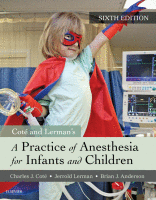Physical Address
304 North Cardinal St.
Dorchester Center, MA 02124

Diabetes Mellitus * * Adapted and updated from Rhodes ET, Ferrari LR, Wolfsdorf JI. Perioperative management of pediatric surgical patients with diabetes mellitus. Anesth Analg. 2005;101:986–999. The incidence of type 1 diabetes mellitus in children is increasing worldwide, and while…

children who require neurosurgical procedures present unique challenges to pediatric anesthesiologists. In addition to addressing problems common to general pediatric anesthesia practice, anesthesiologists must consider the effects of anesthesia on the developing central nervous system (CNS) of children with neurologic…

MILLIONS OF CHILDREN UNDERGO SURGERY with anesthesia every year. During the perioperative period they are exposed to a multitude of stressors capable of interfering with normal brain development. Pain, stress, inflammation, hypoxia, and ischemia have all been shown to adversely…

DISORDERS OF THE NERVOUS SYSTEM are common in childhood, and their diverse manifestations and complications may lead to diagnostic and surgical interventions that require anesthesia. Children with these disorders are subject to the same acute illnesses, such as acute appendicitis,…

THE NATURAL HISTORY OF CONGENITAL HEART DISEASE (CHD) has been favorably altered over the past several decades by remarkable advances in medical and surgical care. These refinements have resulted in decreased morbidity and improvement in long-term outcomes in affected children.…

THE USE OF CATHETERIZATION in the care of children with congenital heart disease (CHD) was first described by Dexter and colleagues in 1947 with the first interventional procedure, balloon atrial septostomy, subsequently described by Rashkind and Miller in 1966. Over…

THE NUMBER OF INFANTS and children who are hospitalized each year with cardiorespiratory collapse that requires artificial support is substantive. Despite maximal medical therapy, failure of the cardiac and/or respiratory systems to provide adequate end-organ perfusion and oxygenation often results…

BLEEDING IS AN INEVITABLE CONSEQUENCE of surgery and trauma. Provided the coagulation processes are normal, a meticulous hemostatic surgical technique is usually adequate to achieve hemostasis for most surgical procedures. However, if the degree of injury is more extensive, major…

THIS CHAPTER REVIEWS THE equipment and strategies for cardiopulmonary bypass (CPB) in infants and children, focusing on how they differ compared with CPB in adults. We review the effects of CPB on the key organ systems and discuss specific management…

THE CARDIOVASCULAR SYSTEM plays a dominant role within the human body: a centrally located “powerhouse” provides oxygen and nutrients via an extensive network of vessels and capillaries throughout the body. All other organ systems depend on its normal development and…